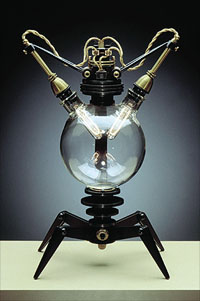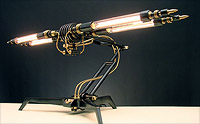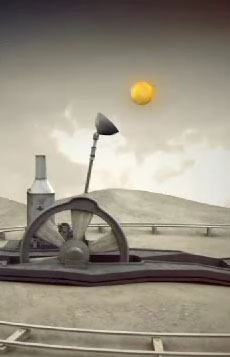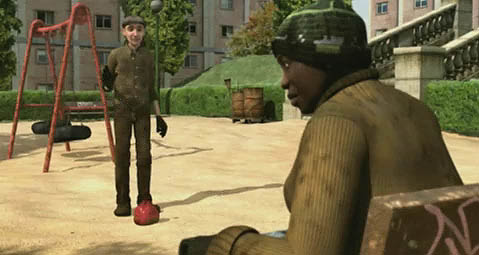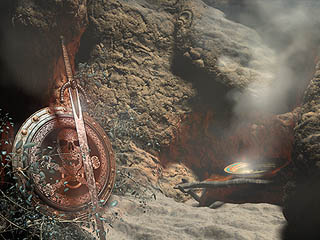
I thought I was pretty well acquainted with the major early 20th century industrial designers – like Norman Bel Geddes , Raymond Loewy
, Raymond Loewy , and Henry Dreyfuss
, and Henry Dreyfuss – until I was talking about them one day with an artist on my (then) team. He’d come from Wisconsin, where he’d studied at Brooks Stevens’ school and later worked at his firm. Stevens himself wasn’t working any more, but he still turned up from time to time. So I did a bit of homework. Which at last led me to this book.
– until I was talking about them one day with an artist on my (then) team. He’d come from Wisconsin, where he’d studied at Brooks Stevens’ school and later worked at his firm. Stevens himself wasn’t working any more, but he still turned up from time to time. So I did a bit of homework. Which at last led me to this book.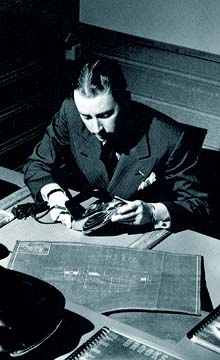

And sure enough, I already knew the man’s work even though I had known nothing about him. Stevens, like those other designers I mentioned, cut his designer’s teeth during the futuristic 1930’s – and like them, he was able to turn his hand to just about anything that was manufactured, from cars to trains to boats to kitchen appliances.
Like Dreyfuss, he was an eminently practical man when it came to product design. But Stevens also had an innate grasp of how people would be affected by the objects he designed. A perfect example of that is the fact that it was Stevens who put a window in a clothes dryer. What had been a featureless cabinet suddenly became animated, hypnotic; the dryers were styled very much like early televisions and in showrooms across the country people just stopped and… watched them. That one decision shows a pointed insight into the way we respond to objects.
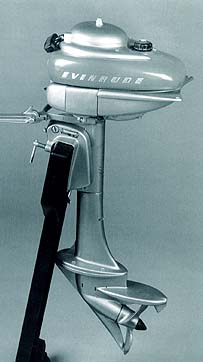 Through his long association with Evinrude, Stevens defined for us what an outboard motor should look like. He often took ungainly machines with jagged, mechanical profiles and streamlined them in casings – just the way designers were encasing steam engines in rocket-shaped, teardrop shells. Likewise he worked for many years for Studebaker, and – not to neglect the the ridiculous – he reinvented Oscar Mayer’s Wienermobile.
Through his long association with Evinrude, Stevens defined for us what an outboard motor should look like. He often took ungainly machines with jagged, mechanical profiles and streamlined them in casings – just the way designers were encasing steam engines in rocket-shaped, teardrop shells. Likewise he worked for many years for Studebaker, and – not to neglect the the ridiculous – he reinvented Oscar Mayer’s Wienermobile.
Yet one of his best remembered legacies of the 1950’s is his invention of the phrase “planned obsolescence”. He saw this as “instilling in the buyer the desire to own something a little newer, a little better, a little sooner than is necessary.” That’s far from the most sinister application of the phrase – which is to design products so that they will intentionally wear out within a certain timeframe, so that the buyer has no choice but to buy again.
 Even in its more aboveboard meaning there’s a kind of manipulation in the idea that doesn’t sit well with us. But in the past three decades industries have gone far beyond this, with the scheduled introduction of incompatible hardware, data formats, and operating systems, so that we are expected to buy the same content again and again to work on these new devices – especially where the older ones are no longer available. Steven’s phrase and intent seem somehow innocent, at this stage.
Even in its more aboveboard meaning there’s a kind of manipulation in the idea that doesn’t sit well with us. But in the past three decades industries have gone far beyond this, with the scheduled introduction of incompatible hardware, data formats, and operating systems, so that we are expected to buy the same content again and again to work on these new devices – especially where the older ones are no longer available. Steven’s phrase and intent seem somehow innocent, at this stage.
This handsome book gives us many examples of Stevens’ designs from every period from the 1930s to the late 1970s, and a good deal of insight into the ideas and client relationships that lay behind those designs.
One of the things that pleases me about these designers is the total world canvas they were able to paint. In the late 20th century industries became more and more specialized. But in the century’s early days it was more than ever possible to be a generalist – in any field, not just in design – and the overall style of the period makes their collective work somehow hang together, like the inevitable result of ongoing progress. It’s a fascinating period to study, and – maybe – to envy, just a little.
This entry was posted on Saturday, July 21st, 2007
and was filed under Reading / Watching / Consuming
There have been 2 Responses »

This is a test rendering of a natural landscape which I rendered in 3DS Max 8. The terrain’s from a height map I generated with the free version of World Machine. This height map became a Displacement map in 3DS Max.
I’ve written up a tutorial on how I created the height map (in World Machine) and turned it into a textured 3D landscape using 3DS Max. You can read the whole review/tutorial here.
This entry was posted on Wednesday, July 18th, 2007
and was filed under Computer Graphics, Works in Progress
There have been 3 Responses »
I must have started thinking about Saga Shirts in early 2005, though it might have been a bit earlier. There were two things that combined to make it happen.
 First, I’d been very happy with my print-on-demand web sites like “Celtic Art & Retro-Futuristic Design” and “The Retrovert“. But one problem with print-on-demand (at least then) was that there was no way to get good quality printing on black or dark colored shirts. I was asked for black shirts more often than anything else, I think. There just wasn’t any way to offer them that I felt good about selling, through a print on demand service; you still really needed to go with traditional silk screen printing.
First, I’d been very happy with my print-on-demand web sites like “Celtic Art & Retro-Futuristic Design” and “The Retrovert“. But one problem with print-on-demand (at least then) was that there was no way to get good quality printing on black or dark colored shirts. I was asked for black shirts more often than anything else, I think. There just wasn’t any way to offer them that I felt good about selling, through a print on demand service; you still really needed to go with traditional silk screen printing.
(more…)
This entry was posted on Tuesday, July 17th, 2007
and was filed under Print On Demand, Works in Progress
There have been no responses »
Frank Buchwald’s gallery for his series of “Machine Lights” sculptures is either a collection of what I’d like to install at the Secret Laboratory, or maybe a collection of things I wish I’d designed myself.
 Some of these look like something that crept out of Tesla’s brain, while others are more the sort of Buck Rogers chic that I hope is my own province.These are artfully made objects, certainly not toys – spend some time with those detail shots to see just what Buchwald’s up to here. There are hand-blown glass bulbs and tubes, and individually machined and finished parts in steel and brass.
Some of these look like something that crept out of Tesla’s brain, while others are more the sort of Buck Rogers chic that I hope is my own province.These are artfully made objects, certainly not toys – spend some time with those detail shots to see just what Buchwald’s up to here. There are hand-blown glass bulbs and tubes, and individually machined and finished parts in steel and brass.
I just love the demented craftsmanship in these. The lights are available in limited numbers, but as far as I can tell there’s no pricing information available unless you contact the artist. I’ve got a feeling they’ll be beyond my means unless this ATM-Dispersal Ray I’m tinkering with works out. But by all means – go look!
This entry was posted on Saturday, July 14th, 2007
and was filed under Found on the Web
There has been 1 Response »
“Solar“, by Ian Wharton and Edward Shires, is a short animated film that shows us just how badly things may go wrong even in a universe that runs on sustainable, low technology mechanics. Well. That’s sort of what it shows us.
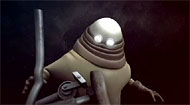 Fortunately even low tech cosmology has some built in safeguards.
Fortunately even low tech cosmology has some built in safeguards.
The two artists behind the film recently graduated from the Cumbria Institute of the Arts, where their film took a best-of-show award. It’s got a lovely paynes’ grey and sepia palette for its steampunkish clockwork universe, and it’s easy to see why it won in competition.
This entry was posted on Thursday, July 12th, 2007
and was filed under Computer Graphics, Found on the Web
There have been no responses »
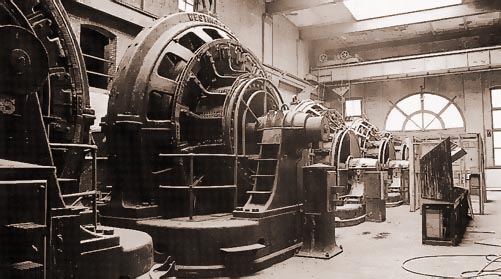
Christopher Payne’s photographs are a sort of urban archaeology that digs down not through sand or sediment, but through the layers of our forgetfulness. Because these remarkable industrial monuments are still there. They’re just ignored.
are a sort of urban archaeology that digs down not through sand or sediment, but through the layers of our forgetfulness. Because these remarkable industrial monuments are still there. They’re just ignored.
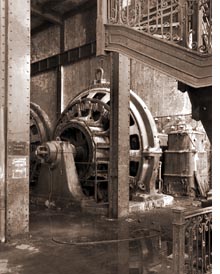 Some of these subway power substations are still in use, rebuilt and equipped with more modern equipment; while many, which make for the most interesting pictures, are abandoned. Those photographs are dreadfully still and fascinating – peeling paint, drifts of debris, and pools of standing water frame the massive power converters and banks of switches and gauges in these innocuous buildings, sprinkled throughout the city.
Some of these subway power substations are still in use, rebuilt and equipped with more modern equipment; while many, which make for the most interesting pictures, are abandoned. Those photographs are dreadfully still and fascinating – peeling paint, drifts of debris, and pools of standing water frame the massive power converters and banks of switches and gauges in these innocuous buildings, sprinkled throughout the city.
A power substation received power from one or more powerhouses through massive underground cables. The power converters look like gigantic turbines. Their function was to spin, powered by the incoming AC current, and by spinning generate the DC current that powered the subway.
 Payne’s book includes period photographs of manned substations, several shots of the exteriors of these buildings, which blend into their setting and are largely ignored, and – best of all, for me – the photographs of these lost installations with their titanic machinery in decay.
Payne’s book includes period photographs of manned substations, several shots of the exteriors of these buildings, which blend into their setting and are largely ignored, and – best of all, for me – the photographs of these lost installations with their titanic machinery in decay.
The pictures make wonderful reference, which was my reason for getting the book, but they’re beautiful and interesting in their own right. I’m a sucker for early 20th century technology and machinery, of course. But I don’t think you need to be, to be moved by the neglect and decay of these immense machines that once were the embodiment of our progress and hope for the future.
This entry was posted on Wednesday, July 11th, 2007
and was filed under Reading / Watching / Consuming
There have been no responses »
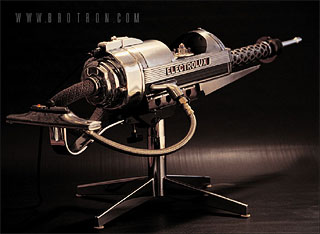 I like the way Greg Brotherton thinks. His online gallery shows us demented retro-futuristic devices like the Electrolux Death Ray, the Sunbeam Heat Ray, and the Hydraulic Robo-Slab; just the sort of equipment I need for the Secret Laboratory.
I like the way Greg Brotherton thinks. His online gallery shows us demented retro-futuristic devices like the Electrolux Death Ray, the Sunbeam Heat Ray, and the Hydraulic Robo-Slab; just the sort of equipment I need for the Secret Laboratory.
Do not, on any account, miss the Electrolux Death Ray commercial. You will definitely not want to be the last on your block to own one of these babies.
 And of course in addition to the household appliances there are some fascinating robotic sculptures like the Minitron, an insectoid robotic minotaur. Honestly, that’s a phrase I never thought I’d use.
And of course in addition to the household appliances there are some fascinating robotic sculptures like the Minitron, an insectoid robotic minotaur. Honestly, that’s a phrase I never thought I’d use.
Anyway, these are about as close as I’m likely to get to the mad scientist appliance I really need – the Omnidirectional Disintegrating Weed Eater. Though one can hope.
This entry was posted on Sunday, July 8th, 2007
and was filed under Found on the Web
There have been no responses »
“Homeless” is an interesting animated short film by Eduardo Suazo; if you’re used to brief, frenetically paced animations you’ll probably hate it, but it’s well worth your time.
It’s technically proficient but it does raise the question of why, if this were the film you wanted to make, you’d animate it rather than shooting it in live action. The few (though important) effects in the film could as easily be done in either case. I guess when it comes down to it, the answer is that if you’re an animator, you use the tools you have. Anyhow, those musings aside, an interesting piece.
Swept up from 3D Total.
This entry was posted on Saturday, July 7th, 2007
and was filed under Computer Graphics, Found on the Web
There have been no responses »
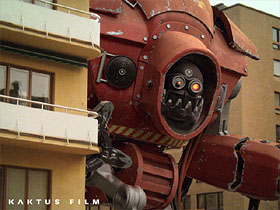 Short on story but big on photo-realistic gonzo-ism, “Mega Robot Returns” is a test piece from Kaktus Films in Sweden.
Short on story but big on photo-realistic gonzo-ism, “Mega Robot Returns” is a test piece from Kaktus Films in Sweden.
Possibly an answer to that age-old question: “Why don’t those nuclear dinosaurs and invading alien cyborgs ever smash Stockholm?”
But I’m still left wondering what, exactly, happened to the dog.
Discovered at 3D Total.
This entry was posted on Friday, July 6th, 2007
and was filed under Computer Graphics, Found on the Web
There have been no responses »
I’ve posted a previously unpublished “Making of” article I wrote for my winning entry (several years ago) in a 3D art contest at 3dLuvr.com – it’s not as in depth as I might like, but it does explain some of the experiments I was doing at that time: mainly, using displacement mapping to create interesting terrain.
You can find the article here.
This entry was posted on Friday, July 6th, 2007
and was filed under Computer Graphics, Works in Progress
There have been no responses »

, Raymond Loewy
, and Henry Dreyfuss
– until I was talking about them one day with an artist on my (then) team. He’d come from Wisconsin, where he’d studied at Brooks Stevens’ school and later worked at his firm. Stevens himself wasn’t working any more, but he still turned up from time to time. So I did a bit of homework. Which at last led me to this book.

 Through his long association with Evinrude, Stevens defined for us what an outboard motor should look like. He often took ungainly machines with jagged, mechanical profiles and streamlined them in casings – just the way designers were encasing steam engines in rocket-shaped, teardrop shells. Likewise he worked for many years for Studebaker, and – not to neglect the the ridiculous – he reinvented Oscar Mayer’s Wienermobile.
Through his long association with Evinrude, Stevens defined for us what an outboard motor should look like. He often took ungainly machines with jagged, mechanical profiles and streamlined them in casings – just the way designers were encasing steam engines in rocket-shaped, teardrop shells. Likewise he worked for many years for Studebaker, and – not to neglect the the ridiculous – he reinvented Oscar Mayer’s Wienermobile.
 Even in its more aboveboard meaning there’s a kind of manipulation in the idea that doesn’t sit well with us. But in the past three decades industries have gone far beyond this, with the scheduled introduction of incompatible hardware, data formats, and operating systems, so that we are expected to buy the same content again and again to work on these new devices – especially where the older ones are no longer available. Steven’s phrase and intent seem somehow innocent, at this stage.
Even in its more aboveboard meaning there’s a kind of manipulation in the idea that doesn’t sit well with us. But in the past three decades industries have gone far beyond this, with the scheduled introduction of incompatible hardware, data formats, and operating systems, so that we are expected to buy the same content again and again to work on these new devices – especially where the older ones are no longer available. Steven’s phrase and intent seem somehow innocent, at this stage.







 First, I’d been very happy with my print-on-demand web sites like “
First, I’d been very happy with my print-on-demand web sites like “
